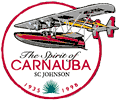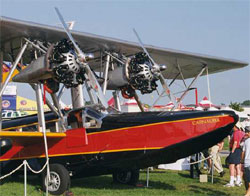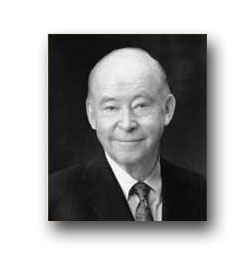| Samuel C.
Johnson Bio
In
1967, Sam became
chairman of S. C. Johnson & Son, Inc., and turned a $171 million
wax
company into a thriving, multi-billion dollar privately-held empire of
four global companies employing more than 28,000 people. The fourth
generation
of his family to lead the family business, Sam observed that “every
generation
must bring something new” to the enterprise. He brought diversification
and globalization to grow the business 40 times over, creating billion
dollar brands like Glade®, Raid® and Pledge® and bringing
Windex®
and Ziploc® into the family’s portfolio. Sam created the modern new
product development organization in 1957 that remains the definitive
model
for companies still today. He summed up his business strategy simply
as:
“New products, new geographies, and every few years, an
acquisition.”
Today the Johnson name sells household packaged goods,
institutional
products and services, an array of financial services and outdoor
recreation
products in more than 110 cuntries worldwide.
Sam
brought family front
and center in the family enterprises. He pioneered groundbreaking
family-friendly
policies, which have helped to earn his businesses “best place to work”
recognition around the world, even integrating family into
corporate
marketing campaigns. His film, Carnauba, A Son’s Memoir was a
testament
to the importance he placed on family personally and professionally.
Sam
cultivated and sustained the strong values and high ethical standards
of
the Johnson leaders before him, and upon which the companies have
flourished.
He was the catalyst and architect of This We Believe in 1976
which
is the touchstone of these principles and philosophy, and continues to
guide corporate actions yet today.
As his
companies and profits
multiplied, so did his philanthropic endeavors. While most companies
hold
corporate giving below 2 percent, Sam kept his at 5 percent, giving
generously
to efforts to improve the quality of life around the world,
particularly
in the areas of environment, education and the arts. Scholarships,
grants
and endowments totaled more than $200 million while he was Chairman,
benefiting
a variety of notable local, national and global causes and
organizations,
including among others: Cornell University, The 21st Century
Preparatory
School, Next Generation Now, the Martin Luther King, Jr.
Birthplace
Museum, Sustainable Racine, The Nature Conservancy, the Smithsonian,
The
Prairie School, the Racine Art Museum and the Downtown Racine
Corporation.
Described
by Fortune
magazine as "corporate America’s leading environmentalist,” Sam
was
a founding member of the World Business Council for Sustainable
Development,
and was named in 1993 to the U.S. President’s Council on Sustainable
Development.
From 1990 to 2000, he served on the Board of Governors for The
Nature
Conservancy, acting the last two years as Chairman of the Board of
Governors.
Most recently, he was a director of the World Resources institute.
His
civic service included
23 years on the Board of Trustees at the Mayo Foundation, serving as
Chairman
of the Board for seven years, and most recently as Trustee Emeritus. He
was a member of the President’s Council of the Experimental Aircraft
Association,
a Regent Emeritus of The Smithsonian Institution, and a member of the
Council
of Advisors for the National Geographic Society. He was Chairman of the
Board of The Johnson Foundation, Inc.
Sam’s
leadership
was recognized with many awards throughout his life. In 1992, he
received
a Lifetime Environmental Stewardship Award from the United Nations
Environment
Program. In 1993, he was inducted into the U.S. National Business Hall
of Fame by the Board of Editors of Fortune magazine. In 1994, he was
presented
the Charles A. Lindbergh Award for his lifetime of contributions to
furthering
the balance between technological advancement and environmental
preservation.
In 1995, he was presented the Rene Dubos Environmental Award for
leadership
and commitment to improving both natural and cultural environments. In
1997, he was presented the Experimental Aircraft Association’s Freedom
of Flight Award for his contributions to aviation.
Among
his many other awards,
he was honored with the Order of the Sacred Treasure by the Emperor of
Japan, the Silver Medal of Paris by Jacques Chirac, and the Order of
the
Civil Merit by the King of Spain.
In 2000,
Sam stepped down
as Chairman of SC Johnson having successfully transitioned leadership
of
three family enterprises to his children. The passing of the baton to
the
fifth generation of family business leaders was perhaps his
proudest
moment, achieving
what only a handful of family companies have ever done. He was
currently
serving as a Director of Johnson Outdoors Inc.; Chairman of the Board
of
Johnson Financial Group; Chairman of the Advisory Council of the
Johnson
Graduate School of Management at Cornell University, Trustee Emeritus
and
Presidential Councilor of the University; and, Founding Chairman
Emeritus
of The Prairie School, a leading college-preparatory day school founded
by his wife in 1965.
Sam
earned degrees
from Cornell and Harvard Business School and served for two years as an
U.S. Air Force intelligence officer. He held seven honorary doctoral
degrees.


|
|
The
Spirit Of Carnauba
Take a
1928
biplane amphibian and a 7500-mile aerial adventure to the primitive
jungles
of Brazil, and what have you got? Johnson's Wax!
By James
Lawrence

ONCE
UPON A TIME,
A MAN WHO RAN A STRUGGLING FAMILY COMPANY DURING THE GREAT DEPRESSION
HAD
A VISION. He would make a daring journey in his fabulous flying boat in
the hope of revitalizing the company's flagging fortunes.

The man
who
would build Pan Am's famous transatlantic Clippers, Igor Sikorsky, also
inspired the design of the S-38 Flying Boat. The Johnsons' original
airplane
was lost in an accident in 1928, but 60 years later, a meticulously
crafted
copy would take to the air. With its finely appointed cabin wrapped by
a fuselage of hardwoods, the S-38 left Racine, Wis., for Brazil.
This is
the story
of how his son, heir to that company once known as Johnson's Wax (today
called S.C. Johnson), had his own epiphany: to re-energize the company
and family spirit by making the same flight 60 years later—in the
identical
airplane his father had flown.
There
was just
one rather formidable obstacle: The wonderful amphibian biplane that
had
carried Samuel Curtis Johnson's father all the way to Brazil in 1935
had
unceremoniously sunk to the bottom of Manokwari Bay, Indonesia, in
1938.
There were no others in existence anywhere in the world.
Imagine
this wonderfully
sleek, 1930s-era speedboat, handcrafted in expensive hardwoods and
lavishly
decked out in cabin upholstery, curtains and appointments befitting a
classy
yacht. Now rig up a couple of wings and slap on two 450-hp Pratt &
Whitney R-985 Wasp Junior engines, and you've got the quintessential
Terry
and the Pirates-era amphibian: the Sikorsky S-38 Flying Boat.

ABOVE
AND LEFT:
The handcrafted stringers and elegant lines of the "hull" favor the
lines
of a classic speedboat more than an airplane. It's only with the wings
and the addition of two Pratt & Whitney engines that the craft's
true
mission becomes evident. BELOW: The Johnson family poses beside the
reincarnated
Spirit
of Carnauba.
"Our
trip to Brazil
in many ways exemplifies the company spirit that began with my father,"
says Sam from his corporate office in Racine, Wis. "He believed there
was
a world market out there for our enterprise. His vision is our
continuing
inspiration. The trip I wanted to make was meant to keep that spirit
alive."
It
turned out to
be one of the greatest experiences of Sam's life, just as it had been
for
his father, Herbert Fisk Johnson.
S.C.
Johnson went
through the same agonies that other businesses suffered during the
Great
Depression. "My father took over in 1928, in his late 20s," Sam
explains,
"and almost immediately the company seemed to be evaporating around
him."
Although
he was
determined to keep his company afloat, Herbert was concerned that the
supply
of the carnauba palm—the tall, slender tree that forms wax on the lower
surfaces of its leaves—might become depleted.
"Carnauba
wax made
our product better than anybody else's," says Sam. "At the time, it
grew
only in northeastern Brazil. So Dad decided he had to go to that place,
where very few people from up north had ever been, to ensure the future
supply of carnauba."
When
Herbert was
told it would take a year by traditional land or sea routes, too long a
leave of absence for a corporate head, he searched for alternatives.
"And
he bought this used airplane," Sam remembers, "a Sikorsky S-38 Flying
Boat.
He planned out the trip for a year, hired a 27-year-old Navy pilot, and
off they went to learn the secrets of the carnauba palm."
The
flight went
off without a hitch. Herbert was eventually able to bring back a wealth
of information on the growth, cultivation and refining of carnauba
wax.
"From
that time
forward, everything turned around for the company," Sam notes.
Today,
S.C. Johnson
is a multi-billion-dollar company that markets products in more than
100
countries worldwide. With all that success and a congenial, cohesive
brood
of spirited fifth-generation Johnsons to take over the four family
enterprises,
what need could there be to stoke an already blazing fire?
"My dad
had written
a book about his flight, mostly for friends and the company. Ten years
ago, I found the copy that he had given me when I was eight years old.
I'd completely forgotten about it. Inside, he'd written, 'To Sammy, I
hope
you make this trip someday.'
"That
simple inscription
changed my life," Sam continues. "I reread it and started thinking
about
it. Something must have happened to him on that trip. Maybe I could
better
understand what he was all about—reconnect with what he was thinking
and
trying to accomplish."
|
 Sadly,
we have lost yet another aviation pioneer, environmentalist and great
humanitarian,
this year... Samuel C. Johnson. He was one of the founders of the EAA’s
Young Eagles program. He died of cancer in his home in Racine,
Wisconsin,
May 22 at the age of 76.
Sadly,
we have lost yet another aviation pioneer, environmentalist and great
humanitarian,
this year... Samuel C. Johnson. He was one of the founders of the EAA’s
Young Eagles program. He died of cancer in his home in Racine,
Wisconsin,
May 22 at the age of 76.





